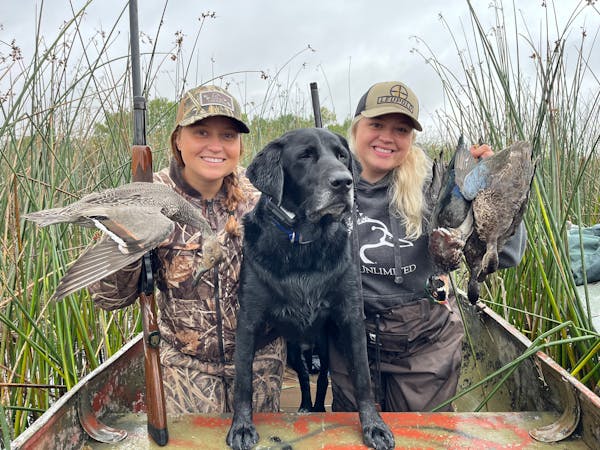With the return of duck hunting this weekend, Minnesota's fall harvest of wild game is reaching a gallop that will intensify during next month's pheasant opener and then peak in early November with the state's classic, nine-day firearms season for whitetail deer.
Once again, this year's deer hunting outlook is dismal for much of northern Minnesota, where back-to-back severe winters contributed to a recent decision by the Department of Natural Resources to lower bag limits in 38 different permit areas.
But in 12 permit areas elsewhere in the state, bag limits have been increased. Wildlife managers will be hoping for an upswing in total harvest after last year's take of 172,265 whitetails fell 12.5% below 2022's mark of 197,000. DNR's big-picture deer management goal is for hunters to annually take down 200,000 deer. Archery hunting for deer, including crossbows for anyone, started Sept. 16.
Bear
Hot weather and natural food abundance have contributed to a big slowdown in the harvest of bears this year. The season opened Sept. 1. As of Monday, hunters had registered 1,305 bruins, 25% fewer than last year over the same time period.
DNR large carnivore specialist Dan Stark said bears were less active early on because temperatures soared. More importantly, he said, fall foods appear to be in abundance, especially acorns. A natural foods survey is still in progress, but Stark said it's telling that 65% of bears harvested as of Sept. 18 were male. Females are more wary than males when it comes to approaching bait stations, but in bad food years, the harvest ratio of males to females is closer to 50-50. About 8,000 people a year hunt bears in Minnesota.
Ruffed grouse
Back-to-back snowy winters may have boosted ruffed grouse populations judging from drumming counts this spring and favorable brood sightings throughout the summer. That's a familiar conclusion being drawn by hunters after one week of hunting, said the DNR's Ted Dick, an avid upland hunter based in Grand Rapids.
"It's already a good year," Dick said after hunting in several locations during the season's first weekend Sept. 16-17. As more trees lose leaves, conditions should only improve.
Dick said it's rare for him to hear so many good brood counts from fellow conservationists. The positive reports jibe with expectations raised by two consecutive winters with snow that has been deep enough to provide the birds with thermal protection and good cover from predators.
According to a DNR survey, about 64,500 hunters last season harvested about 237,700 ruffed grouse — estimates that are 14% and 10%, respectively, below the 10-year averages. The survey estimated 69% of ruffed grouse hunters were successful and the mean harvest per successful hunter was 5.4 grouse — on par with 10-year averages.
As with waterfowl, woodcock season opens this weekend. The DNR's annual August roadside survey reported good numbers.
Minnesota pheasant
Our state keeps losing grassland habitat needed for ringnecks, but the birds showed their resilience once again by surviving the tough winter and raising enough chicks to increase their relative density by an average of 10% statewide.
That was a central finding of this year's August roadside wildlife survey. Based on those results, the agency produced a map that shows the strongest hunting regions are in three general areas: the southwestern corner including Lincoln, Lyon and Nobles counties; just north of there in Big Stone, Chippewa and Yellow Medicine counties; as well as pockets in the south-central counties of Brown, Watonwan and Cottonwood.
In Steele County, where Gov. Tim Walz is planning to celebrate the Governor's Pheasant Hunting Opener on Oct. 13-14, the DNR map describes hunting prospects as "poor" and "very poor."
DNR upland game research scientist Tim Lyons said the best news for pheasant hunters this year was the growth in bird counts in the roadside survey. Winter was brutal, but ringnecks "often times surprise us with how well they can do," he said.
Even with continued losses of grassland habitat, DNR estimated a doubling of pheasants in the area south and west of Redwood Falls.
South Dakota pheasants
Rooster counts in South Dakota are still the envy of many Minnesota pheasant hunters, even though there's been a major downgrade of bird density brought about by the ongoing conversion of prairie grass to row crops.
For nonresidents of South Dakota, this year's hunt starts Oct. 21. The state's Game, Fish and Parks Department no longer estimates pheasant numbers prior to the season, but the agency estimated 2022's harvest at more than 1.15 million birds — the most in the past five years. (Minnesota's 2022 harvest estimate was 204,000 birds.)
Matt Gottlob is the South Dakota state coordinator for Pheasants Forever. He was quoted in the organization's 2023 hunting forecast saying South Dakota had pretty good nesting conditions this spring. "We're seeing a good amount of broods, and the size of the broods has been average to above average," he said.
The forecast says hopes are high that this year's season could be similar or better than last year.
Governor's deer opener
The Minnesota Deer Hunters Association snubbed Walz earlier this year by dropping its long-standing partnership in the Governor's Deer Opener.
The group said Walz's "continued attempts to ban wolf hunting" and his support of "anti-gun legislation" are in direct opposition to the association's mission. Since then, the governor's office has been working to keep the tradition alive with at least one new partner, a smaller hunters' group known as Bluffland Whitetails Association.
Group president Taylor Bestor told the Star Tribune this week there's a 99% certainty the event will take place Nov. 3-4 at Eagle Bluff Environmental Learning Center near Lanesboro.
The tentative outline for the celebration will include a "mentor-mentee" hunt on Saturday, as well as festivities on Friday, Bestor said. The center's campus includes wilderness acreage, target shooting facilities, a commercial kitchen and a two-story dormitory.
A $2.8 billion settlement will change college sports forever. Here's how

Reusse: Country boy Jim Marshall never lost his lust for life

Twins open homestand with loss to Blue Jays, Jeffers ejected after critical call

Vikings GM talks to the Star Tribune about the team's 2025 outlook, McCarthy's trajectory


